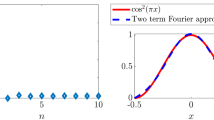Abstract
Bifurcation theoretical and numerical analyses of one of Turing's models are performed. It is shown that at the first instability point of the homogeneous state the bifurcating branches aresubcritical, and thus emerge as unstable solutions. This, together with the presence of concentration-independent sink terms is responsible for the solutions becoming negative ast→∞. It is pointed out that this deficiency is an accident related to the choice of the model, and that the general idea of symmetry-breaking is perfectly compatible with the generation of regular morphogenetic patterns.
Similar content being viewed by others
Literature
Auchmuty, J. F. G. 1976. University of Essex, preprint.
Auchmuty, J. F. G. and G. Nicolis. 1975. “Bifurcation Analysis of Nonlinear Reaction-Diffusion Equations—I. Evolution Equations and the Steady State Solutions.”Bull. Math. Biol.,37, 323–365.
Auchmuty, J. F. G. and G. Nicolis. 1976. “Bifurcation Analysis of Nonlinear Reaction-Diffusion Equations—III Chemical Oscillations”Bull. Math. Biol.,38, 325–350.
Babloyantz, A. and J. Hiernaux. 1975. “Models for Cell Differentiation and Generation of Polarity in Diffusion Governed Morphogenetic Fields.”Bull. Math. Biol.,37, 637–657.
Bard, J. and I. Lauder. 1974. “How well does Turing's Theory of Morphogenesis work?”J. Theor. Biol.,45 501–531.
Cooke, J. 1975. “Control of Somite Number During Morphogenesis of a Vertebrate,Xenopus Leavis.”Nature,254, 196–199.
Cooke, J. and E. C. Zeeman. 1976. “A Clock and Wavefront Model for Control of the Number of Repeated Structures during Animal Morphogenesis.”J. Theor. Biol.,58, 455–476.
Fife, P. 1977. Proceedings of NSF-CBMS Regional Conference on Nonlinear Diffusion,Res. Notes Math.,14 81–122.
Gierer, A. and H. Meinhardt. 1972. “A Theory of Biological Pattern Formation.”Kybernetik,12, 30–39.
Glansdorff, P. and I. Prigogine. 1971.Thermodynamics of Structure, Stability and Fluctuations. New-York: Wiley-Interscience.
Herschkowitz-Kaufman, M. 1975. “Bifurcation Analysis of Nonlinear Reaction-Diffusion Equations—II Steady State Solutions and Comparison with Numerical Simulations.”Bull. Math. Biol.,37, 589–636.
Hiernaux, J. 1976. “Modèles Théoriques de la Différenciation Cellulaire et de la Morphogénèse. Ph.D. Thesis (Université Libre de Bruxelles).
Kauffman, S. A., R. M. Shymko and K. Trabert. 1978. “Control of Sequential Compartment Formation inDrosophilia.”Science,199, 259–270.
Martinez, H. M. 1972. “Morphogenesis and Chemical Dissipative Structures: A Computer Simulated Case Study”J. Theor. Biol.,36, 701–725.
Maynard Smith, J. and K. C. Sondhi 1961. “The Arrangement of Bristles inDrosophila.”J. Embryol. Exp. Morph.,9, 661–671.
Meinhardt, H. and A. Gierer. 1974. “Application of a Theory of Biological Pattern Formation Based on Lateral Inhibition.”J. Cell. Sci.,15, 321–346.
Minorski, N. 1962. Non Linear Oscillation. Princeton: Van Nostrand.
Nicolis, G. and R. Lefever. 1975. “Membranes, Dissipative Structures and Evolution”.Adv. Chem. Phys., vol. 29. New-York: Wiley-Interscience.
— and I. Prigogine. 1977.Self-Organization in Nonequilibrium Systems. New York: Wiley.
Othmer, H. G. 1977. “Current Theories of Pattern Formation.”Lect. Math. Life Sci.,9, 57–87.
Prigogine, I. and G. Nicolis. 1967. “On Symmetry-Breaking Instabilities in Dissipative Systems.”J. Chem. Phys.,46, 3542–3550.
— and R. Lefever. 1968. “Symmetry-Breaking Instabilities in Dissipative System.”J. Chem. Phys.,48, 1695–1700.
Sattinger, D. 1973. “Topics in Stability and Bifurcation Theory.” Lecture Notes in Mathematics, vol. 309. Berlin: Springer.
Turing, A. M. 1952. “The Chemical Basis of Morphogenesis.”Phil. Trans. R. Soc., London, B 237, 37–72.
Wolpert, L. 1969. “Positional Information and the Spatial Pattern of Cellular Differentiation.”J. Theor. Biol.,25, 1–47.
Author information
Authors and Affiliations
Rights and permissions
About this article
Cite this article
Erneux, T., Hiernaux, J. & Nicolis, G. Turing's theory in morphogenesis. Bltn Mathcal Biology 40, 771–789 (1978). https://doi.org/10.1007/BF02460606
Received:
Revised:
Issue Date:
DOI: https://doi.org/10.1007/BF02460606



